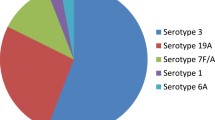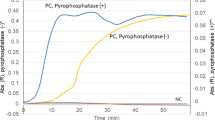Abstract
Serotype 3 is one of the most often detected pneumococcal serotypes in adults and it is associated with serious disease. In contrast, the isolation of serotype 3 by bacterial culture is unusual in children with invasive pneumococcal disease (IPD). The purpose of this study was to learn the serotype distribution of IPD, including culture-negative episodes, by using molecular methods in normal sterile samples. We studied all children <5 years of age with IPD admitted to two paediatric hospitals in Catalonia, Spain, from 2007 to 2009. A sequential real-time polymerase chain reaction (PCR) approach was added to routine methods for the detection and serotyping of pneumococcal infection. Among 257 episodes (219 pneumonia, 27 meningitis, six bacteraemia and five others), 33.5% were identified by culture and the rest, 66.5%, were detected exclusively by real-time PCR. The most common serotypes detected by culture were serotypes 1 (26.7%) and 19A (25.6%), and by real-time PCR, serotypes 1 (19.8%) and 3 (18.1%). Theoretical coverage rates by the PCV7, PCV10 and PCV13 vaccines were 10.5, 52.3 and 87.2%, respectively, for those episodes identified by culture, compared to 5.3, 31.6 and 60.2% for those identified only by real-time PCR. Multiplex real-time PCR has been shown to be useful for surveillance studies of IPD. Serotype 3 is underdiagnosed by culture and is important in paediatric IPD.


Similar content being viewed by others
References
O’Brien KL, Wolfson LJ, Watt JP, Henkle E, Deloria-Knoll M, McCall N et al (2009) Burden of disease caused by Streptococcus pneumoniae in children younger than 5 years: global estimates. Lancet 374:893–902
Zhang Y, Isaacman DJ, Wadowsky RM, Rydquist-White J, Post JC, Ehrlich GD (1995) Detection of Streptococcus pneumoniae in whole blood by PCR. J Clin Microbiol 33:596–601
Muñoz-Almagro C, Gala S, Selva L, Jordan I, Tarragó D, Pallares R (2011) DNA bacterial load in children and adolescents with pneumococcal pneumonia and empyema. Eur J Clin Microbiol Infect Dis 30:327–335
Azzari C, Moriondo M, Indolfi G, Massai C, Becciolini L, de Martino M et al (2008) Molecular detection methods and serotyping performed directly on clinical samples improve diagnostic sensitivity and reveal increased incidence of invasive disease by Streptococcus pneumoniae in Italian children. J Med Microbiol 57:1205–1212
Corless CE, Guiver M, Borrow R, Edwards-Jones V, Fox AJ, Kaczmarski EB (2001) Simultaneous detection of Neisseria meningitidis, Haemophilus influenzae, and Streptococcus pneumoniae in suspected cases of meningitis and septicemia using real-time PCR. J Clin Microbiol 39:1553–1558
Van Gastel E, Bruynseels P, Verstrepen W, Mertens A (2007) Evaluation of a real-time polymerase chain reaction assay for the diagnosis of pneumococcal and meningococcal meningitis in a tertiary care hospital. Eur J Clin Microbiol Infect Dis 26:651–653
Lahti E, Mertsola J, Kontiokari T, Eerola E, Ruuskanen O, Jalava J (2006) Pneumolysin polymerase chain reaction for diagnosis of pneumococcal pneumonia and empyema in children. Eur J Clin Microbiol Infect Dis 25:783–789
Picazo J, Ruiz-Contreras J, Casado-Flores J, Giangaspro E, Del Castillo F, Hernández-Sampelayo T et al (2011) Relationship between serotypes, age, and clinical presentation of invasive pneumococcal disease in Madrid, Spain, after introduction of the 7-valent pneumococcal conjugate vaccine into the vaccination calendar. Clin Vaccine Immunol 18:89–94
Muñoz-Almagro C, Jordan I, Gene A, Latorre C, García-García JJ, Pallares R (2008) Emergence of invasive pneumococcal disease caused by nonvaccine serotypes in the era of 7-valent conjugate vaccine. Clin Infect Dis 46:174–182
Clinical and Laboratory Standards Institute (CLSI) (2010) Performance Standards for Antimicrobial Susceptibility Testing; Twentieth Informational Supplement. M100-S20. CLSI, Wayne, PA, USA
Tarragó D, Fenoll A, Sánchez-Tatay D, Arroyo LA, Muñoz-Almagro C, Esteva C et al (2008) Identification of pneumococcal serotypes from culture-negative clinical specimens by novel real-time PCR. Clin Microbiol Infect 14:828–834
Singleton RJ, Hennessy TW, Bulkow LR, Hammitt LL, Zulz T, Hurlburt DA et al (2007) Invasive pneumococcal disease caused by nonvaccine serotypes among Alaska native children with high levels of 7-valent pneumococcal conjugate vaccine coverage. JAMA 297:1784–1792
Lehmann D, Willis J, Moore HC, Giele C, Murphy D, Keil AD et al (2010) The changing epidemiology of invasive pneumococcal disease in aboriginal and non-aboriginal western Australians from 1997 through 2007 and emergence of nonvaccine serotypes. Clin Infect Dis 50:1477–1486
Fenoll A, Granizo JJ, Aguilar L, Giménez MJ, Aragoneses-Fenoll L, Hanquet G et al (2009) Temporal trends of invasive Streptococcus pneumoniae serotypes and antimicrobial resistance patterns in Spain from 1979 to 2007. J Clin Microbiol 47:1012–1020
Siira L, Rantala M, Jalava J, Hakanen AJ, Huovinen P, Kaijalainen T et al (2009) Temporal trends of antimicrobial resistance and clonality of invasive Streptococcus pneumoniae isolates in Finland, 2002 to 2006. Antimicrob Agents Chemother 53:2066–2073
Harboe ZB, Benfield TL, Valentiner-Branth P, Hjuler T, Lambertsen L, Kaltoft M et al (2010) Temporal trends in invasive pneumococcal disease and pneumococcal serotypes over 7 decades. Clin Infect Dis 50:329–337
Byington CL, Hulten KG, Ampofo K, Sheng X, Pavia AT, Blaschke AJ et al (2010) Molecular epidemiology of pediatric pneumococcal empyema from 2001 to 2007 in Utah. J Clin Microbiol 48:520–525
Weatherholtz R, Millar EV, Moulton LH, Reid R, Rudolph K, Santosham M et al (2010) Invasive pneumococcal disease a decade after pneumococcal conjugate vaccine use in an American Indian population at high risk for disease. Clin Infect Dis 50:1238–1246
Marimon JM, Ercibengoa M, Alonso M, Zubizarreta M, Pérez-Trallero E (2009) Clonal structure and 21-year evolution of Streptococcus pneumoniae serotype 1 isolates in Northern Spain. Clin Microbiol Infect 15:875–877
Nunes S, Sá-Leão R, Pereira LC, Lencastre H (2008) Emergence of a serotype 1 Streptococcus pneumoniae lineage colonising healthy children in Portugal in the seven-valent conjugate vaccination era. Clin Microbiol Infect 14:82–84
Kaplan SL, Barson WJ, Lin PL, Stovall SH, Bradley JS, Tan TQ et al (2010) Serotype 19A is the most common serotype causing invasive pneumococcal infections in children. Pediatrics 125:429–436
Muñoz-Almagro C, Esteva C, de Sevilla MF, Selva L, Gene A, Pallares R (2009) Emergence of invasive pneumococcal disease caused by multidrug-resistant serotype 19A among children in Barcelona. J Infect 59:75–82
Moore MR, Gertz RE Jr, Woodbury RL, Barkocy-Gallagher GA, Schaffner W, Lexau C et al (2008) Population snapshot of emergent Streptococcus pneumoniae serotype 19A in the United States, 2005. J Infect Dis 197:1016–1027
Reinert RR, Reinert S, van der Linden M, Cil MY, Al-Lahham A, Appelbaum P (2005) Antimicrobial susceptibility of Streptococcus pneumoniae in eight European countries from 2001 to 2003. Antimicrob Agents Chemother 49:2903–2913
Imöhl M, Reinert RR, Ocklenburg C, van der Linden M (2010) Association of serotypes of Streptococcus pneumoniae with age in invasive pneumococcal disease. J Clin Microbiol 48:1291–1296
Hausdorff WP, Bryant J, Paradiso PR, Siber GR (2000) Which pneumococcal serogroups cause the most invasive disease: implications for conjugate vaccine formulation and use, part I. Clin Infect Dis 30:100–121
Rückinger S, von Kries R, Siedler A, van der Linden M (2009) Association of serotype of Streptococcus pneumoniae with risk of severe and fatal outcome. Pediatr Infect Dis J 28:118–122
Obando I, Muñoz-Almagro C, Arroyo LA, Tarrago D, Sanchez-Tatay D, Moreno-Perez D et al (2008) Pediatric parapneumonic empyema, Spain. Emerg Infect Dis 14:1390–1397
Bender JM, Ampofo K, Byington CL, Grinsell M, Korgenski K, Daly JA et al (2010) Epidemiology of Streptococcus pneumoniae-induced hemolytic uremic syndrome in Utah children. Pediatr Infect Dis J 29:712–716
Ogami M, Hotomi M, Togawa A, Yamanaka N (2010) A comparison of conventional and molecular microbiology in detecting differences in pneumococcal colonization in healthy children and children with upper respiratory illness. Eur J Pediatr 169:1221–1225
Arbique JC, Poyart C, Trieu-Cuot P, Quesne G, Carvalho Mda G, Steigerwalt AG et al (2004) Accuracy of phenotypic and genotypic testing for identification of Streptococcus pneumoniae and description of Streptococcus pseudopneumoniae sp. nov. J Clin Microbiol 42:4686–4696
Keith ER, Podmore RG, Anderson TP, Murdoch DR (2006) Characteristics of Streptococcus pseudopneumoniae isolated from purulent sputum samples. J Clin Microbiol 44:923–927
Simões AS, Sá-Leão R, Eleveld MJ, Tavares DA, Carriço JA, Bootsma HJ et al (2010) Highly penicillin-resistant multidrug-resistant pneumococcus-like strains colonizing children in Oeiras, Portugal: genomic characteristics and implications for surveillance. J Clin Microbiol 48:238–246
Muñoz-Almagro C, Selva L, Sanchez CJ, Esteva C, de Sevilla MF, Pallares R et al (2010) PsrP, a protective pneumococcal antigen, is highly prevalent in children with pneumonia and is strongly associated with clonal type. Clin Vaccine Immunol 17:1672–1678
Acknowledgements
This work was supported by Fondo de Investigación Sanitaria (FIS, project number 06/1597), Caja Navarra Foundation and AGAUR 2009/SGR00136.
We are very appreciative of Dr. Fenoll (National Center of Microbiology, Majadahonda, Madrid, Spain) for the conventional serotyping of isolates.
This paper was published in part at the 7th International Symposium on Pneumococci and Pneumococcal Diseases (ISPPD-7), Tel Aviv, Israel, March 14–18, 2010 (abstract P-134).
Transparency declaration
P. Ciruela., M.F. de Sevilla, S. Hernandez and J.J. García-García have received a travel grant from Pfizer. F. Moraga has received honoraria for consultancy and speaking at scientific meetings from Pfizer and GSK. L. Salleras has received travel grants and honoraria for speaking at scientific meetings organised by Sanofi Pasteur MSD, GSK, Novartis Vaccines, Pfizer, Crucell Berna and Esteve.
Author information
Authors and Affiliations
Corresponding author
Rights and permissions
About this article
Cite this article
Selva, L., Ciruela, P., Esteva, C. et al. Serotype 3 is a common serotype causing invasive pneumococcal disease in children less than 5 years old, as identified by real-time PCR. Eur J Clin Microbiol Infect Dis 31, 1487–1495 (2012). https://doi.org/10.1007/s10096-011-1468-7
Received:
Accepted:
Published:
Issue Date:
DOI: https://doi.org/10.1007/s10096-011-1468-7




